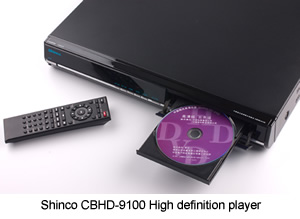
China Blue High-definition Disc Launched to Challenge Blu-ray
The China High-Definition DVD Industry Association (CHDA) on Thursday announced its development plans for the China Blue High-Definition (CBHD) disc format at a conference in Guangzhou.
By next year, the Association plans to see an increase in CBHD vendors from the current 2 companies to 10, with a total of 1,000 CBHD programs offered, and sales of 1 mln CBHD players in 2010, eventually reaching 10 mln units within three years.
The Association also unveiled a new generation CBHD disc, which is based on the Chinese-owned Audio Video Standard (AVS) and copy-protection (DKAA) systems.
CAV Warner Home Entertainment said at the conference that aside from itself, U.S.-based content providers including Universal and National Gepgraphic will also support the CBHD format.
Both CAV Warner and China Record have released dozens of CBHD products, and plan to surpass 100 releases within the year. Video stores, Xinhua bookstores and a number of chain stores nationwide have begun sales, while e-commerce sites Joyo-Amazon and Dangdang also offer CBHD products online. The Association also stated that, in addition to content providers, consumer electronics retail giants Gome and Suning signed sales agreements in August, joining in to promote sales of CBHD players.
The Association added that next year it will focus on developing CBHD players and discs supporting non-Mandarin minority languages.
TCL and Shinco have already developed CBHD players. Li Dongsheng, chairman and president of TCL Corp., believes that changing from "red laser" to "blue laser" is the general trend. Along with the upgrading of Chinese domestic market color TV consumption, the development potential of CBHD products should be enormous.
The CBHD format is backed by China High-definition DVD industry Association (CHDA), the Optical Memory National Engineering Research Center (OMNERC) and the DVD Forum and it is based on Toshiba's HD DVD format.
The format is protected against piracy using the AACS content protection schemes, also used by the Blu-ray format. The Chinese government is supporting the CBHD format and is backing its introduction in China's industries financially. The government has already funded some manufacturers engaged in the CBHD format in order to accelerate CBHD projects.
The potential growth of the format in China has already become clear. In just a couple of months since it was launched, the cheaper all-Chinese CBHD players are thought to be outselling Blu-ray players at a rate of about three to one. The discs, priced at 50 yuan, set consumers back about a quarter of the cost of a Blu-ray.
China?s decision to back the new format ? the Government owns the critical software ? is understood to arise from a desire to protect its electronics industry from the royalty costs of using technology developed overseas. Chinese makers of ordinary DVD players have to pay about $22 per machine in royalty costs to a variety of patent holders; the dominance of Blu-ray would have condemned them to many more years of payments as that technology grew in market share.
From the perspective of Hollywood studios, meanwhile, the sale of movies on a cheap format may temporarily counteract the damage done by piracy. The Blu-ray released in the China territory have been hit by the so-called "BD-9" discs, which are currently sold in China for US$5.00. They are actually DVD-R discs that hold Blu-ray movies that have been re-compressed using the H.264 format. The specific discs are compatible with some Blu-ray players.

The Association also unveiled a new generation CBHD disc, which is based on the Chinese-owned Audio Video Standard (AVS) and copy-protection (DKAA) systems.
CAV Warner Home Entertainment said at the conference that aside from itself, U.S.-based content providers including Universal and National Gepgraphic will also support the CBHD format.
Both CAV Warner and China Record have released dozens of CBHD products, and plan to surpass 100 releases within the year. Video stores, Xinhua bookstores and a number of chain stores nationwide have begun sales, while e-commerce sites Joyo-Amazon and Dangdang also offer CBHD products online. The Association also stated that, in addition to content providers, consumer electronics retail giants Gome and Suning signed sales agreements in August, joining in to promote sales of CBHD players.
The Association added that next year it will focus on developing CBHD players and discs supporting non-Mandarin minority languages.
TCL and Shinco have already developed CBHD players. Li Dongsheng, chairman and president of TCL Corp., believes that changing from "red laser" to "blue laser" is the general trend. Along with the upgrading of Chinese domestic market color TV consumption, the development potential of CBHD products should be enormous.
The CBHD format is backed by China High-definition DVD industry Association (CHDA), the Optical Memory National Engineering Research Center (OMNERC) and the DVD Forum and it is based on Toshiba's HD DVD format.
The format is protected against piracy using the AACS content protection schemes, also used by the Blu-ray format. The Chinese government is supporting the CBHD format and is backing its introduction in China's industries financially. The government has already funded some manufacturers engaged in the CBHD format in order to accelerate CBHD projects.
The potential growth of the format in China has already become clear. In just a couple of months since it was launched, the cheaper all-Chinese CBHD players are thought to be outselling Blu-ray players at a rate of about three to one. The discs, priced at 50 yuan, set consumers back about a quarter of the cost of a Blu-ray.
China?s decision to back the new format ? the Government owns the critical software ? is understood to arise from a desire to protect its electronics industry from the royalty costs of using technology developed overseas. Chinese makers of ordinary DVD players have to pay about $22 per machine in royalty costs to a variety of patent holders; the dominance of Blu-ray would have condemned them to many more years of payments as that technology grew in market share.
From the perspective of Hollywood studios, meanwhile, the sale of movies on a cheap format may temporarily counteract the damage done by piracy. The Blu-ray released in the China territory have been hit by the so-called "BD-9" discs, which are currently sold in China for US$5.00. They are actually DVD-R discs that hold Blu-ray movies that have been re-compressed using the H.264 format. The specific discs are compatible with some Blu-ray players.






















